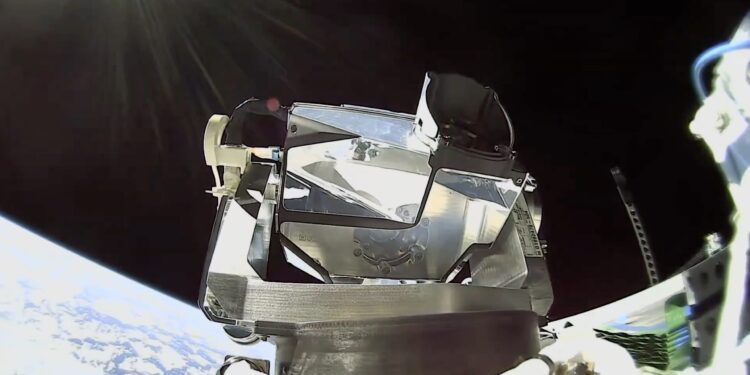
TAMPA, Fla. — SpaceX is supplying optical terminals to Muon Space, the four-year-old Californian manufacturer said Oct. 21, enabling its future Halo satellites to use the Starlink broadband constellation as a global data-relay network.
The “mini laser” terminals would link Halo satellites into Starlink’s growing mesh of optical crosslinks in low Earth orbit (LEO), providing up to 25 gigabits per second of connectivity as far as 4,000 kilometers away.
SpaceX first unveiled plans to sell the terminals to other companies in March 2024, with commercial space station developer Vast announcing plans a month later to integrate them on the Haven-1 spacecraft now slated to launch in 2026.
Muon president Gregory Smirin told <em>SpaceNews the company plans to test the capability in LEO in the first quarter of 2027, ahead of customer deployments the following quarter.
While financial and other details were not disclosed, Smirin said Muon aims to “have this capacity for every one of our customers.”
Each Halo satellite, ranging from around 100-500 kilograms, would typically carry one to four Starlink mini laser terminals, depending on connectivity and redundancy needs.
“I’d say the vast majority of our customers who we’ve talked about this with have expressed interest in one,” Smirin said in an interview, enough for 70-80% persistent connectivity, depending on orbit, as the satellite hands off to new Starlink nodes coming into view.
“That’s still a huge step forward from — depending on what’s being designed for a particular satellite or constellation — anywhere between 10% and 30% connectivity persistence with ground stations,” he added.
Ideal use case
Muon operates its satellites on behalf of customers, who would pay for Starlink usage much like existing ground station services that are based on data volume or access time.
The company has deployed four Halo satellites so far, including a prototype in March for FireSat, a wildfire-monitoring system developed with the nonprofit Earth Fire Alliance that Muon highlighted as an ideal application for the optical connectivity.
Adding Starlink terminals to future FireSat spacecraft could cut data latency from an average of 20 minutes to near real-time, according to Muon, enabling incident commanders and first responders to receive almost instant alerts of new ignitions.
“It’s not just for initial detection,” Smirin added, “the quicker you can update what’s happening with the perimeter, the intensity and the speed of movement, then the easier it is for the incident commanders to be able to move their people on their equipment.
“So really driving down the latency to near zero is a huge operational win.”
While the deal with SpaceX is not exclusive, he said Muon’s vertically integrated approach positions the company to get the most out of the terminal hardware.
“We think that full vertical integration of all the components of hardware that we put into our spacecraft, the software and the operations, sets us up really nicely to make the mini laser terminal the most productive it can be,” he said.
“Because if you put it on something else that’s part of some Frankensat that’s constrained by power or processing or something else, then it’s not going to really perform as well.”
Muon said in June it was buying satellite propulsion startup Starlight Engines as part of its vertical integration strategy, while announcing it had extended its Series B round to $146 million.
Seven Muon satellites are scheduled for launch next year, and Smirin said the company is on track to at least double its output annually as it ramps up production capacity at its new facility in San Jose, California. The company ultimately aims to be able to build up to 500 spacecraft a year.
